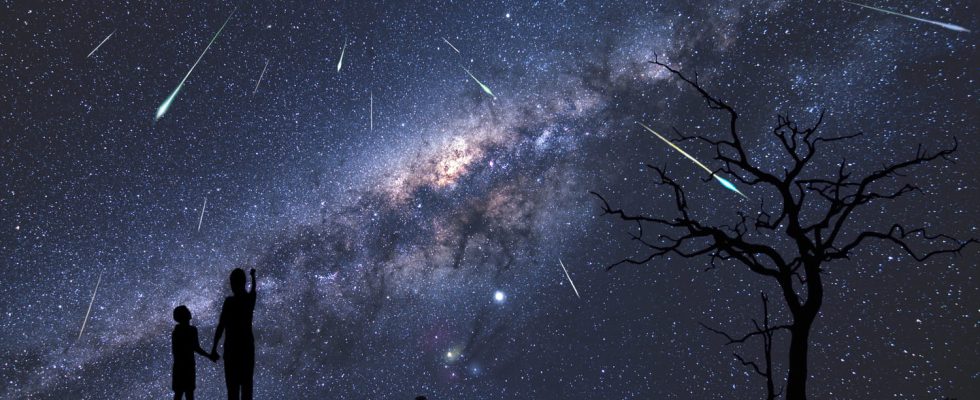SHOOTING STARS. The Perseids, a shower of shooting stars that returns every August, are currently observable in the sky. Here are some tips to make the most of it.
[Mis à jour le 21 août 2023 à 16h14] The Perseids are observable until Thursday August 24th. To make the most of the event, you will have to look up at the sky after sunset, around 10:30 p.m., in order to take advantage of a dark sky.
If some shooting stars are not very bright or the area you are in is not perfectly clear, the Perseid shooting star shower should still give you a good show. Where and how to observe them? Telescope, binoculars or even with the naked eye… which equipment to favor? We tell you all about this astronomical meeting which promises beautiful nights and many wishes!
You can admire shooting stars throughout the Perseid period which extends toto August 24. To do this, wait until the sun has disappeared behind the horizon around 10:30 p.m. so that the sky has turned black.
No danger or need for specific equipment! Shooting stars are visible to the naked eye by everyone. No need therefore to take out the binoculars or the telescope, given the high speed at which the fireballs pass through the Earth’s atmosphere (an average of 50 km/second). About a quarter of shooting stars leave visible trails for several seconds. To be able to observe a shower of shooting stars in an optimal way, the sky must not be obscured by clouds, or by light pollution. To find your way more easily, you can use a mobile application such as Sky Tonight available on Google Play or on theApp Storewhich will allow you to identify the constellations and their position in the sky.
Made up of debris from comet 109P/Swift-Tuttle, the Perseid meteor shower is the most famous of the year because it is one of the most active. This meteoritic swarm in the constellation of Perseus extends from July 17 to August 24, with a peak of activity on the night of August 12 to 14. It is the most spectacular of all, with 100 observable shooting stars per hour, or an average of one shooting star per minute!
After the Perseids, several major stellar meetings of shooting stars take place during the 2023/2024 calendar. Check out the most notable meteor showers that appear in the sky throughout the year, in chronological order of appearance below:
- The Orionids : active from October 2 to November 7, these shooting stars are particularly observable from October 20 to 21, in mid-autumn. The Orionids, named after the constellation Orion (easy to recognize, its seven brightest stars form a bow tie or slightly tilted hourglass!), are visible in the northern hemisphere at this time of year . Depending on the year, between 20 and 30 shooting stars pierce the sky every hour.
- The Leonids are a cluster of dust, or meteoroids, made up of debris from comet 55P/Tempel-Tuttle. With their radiant located in the zodiac constellation of Leo, the Leonid meteor shower appears from November 6 to November 30 with peak activity on November 18. If nearly 200 shooting stars are observable in the sky per hour, every 33 years (in 2031), the spectacle becomes unforgettable after the passage of comet 55P/Temple-Tuttle: the shower of shooting stars then turns into a real storm, with thousands of meteors in one night!
- The Geminids are observed each winter in December, generally from December 4 to 20 with a peak of activity on December 14. We can expect between 60 and 75 meteors per hour and up to 120 to 160 meteors per hour during peak activity. The Geminids come from a celestial object named “3200 Phaeton”, an asteroid which is speculated to be the nucleus of an ancient comet, which orbits the Sun. Each year, when the Earth passes through the dust cloud thus generated, the Geminid meteor shower takes place.
- The Ursids : this meteor shower is active from December 17 to 26, associated with comet 8P/Tuttle. The peak of the Ursids takes place just before Christmas on the night of December 21 to 22. It is of low intensity, with 10 to 50 meteors per hour.
- The Quadrantids : active during the winter nights between January 1 and 3, they display a rate of 120 meteors per hour, during the night of January 2 and 3. They originate from the sleepy comet 2003 EH1.
- The Lyrids : located in the constellation Lyra and active from April 16 to April 26, the Lyrid meteor shower peaks on the night of April 23, with a rate of 5 to 20 observable meteors per hour. It is associated with comet C/1861 G1 Thatcher.
- The Eta Aquarids : active from April 19 until May 28, mainly visible in the southern hemisphere, the meteor shower is supplied by comet Halley. Its peak is located on the night of May 5-6, with a rate of 70 meteors per hour.
